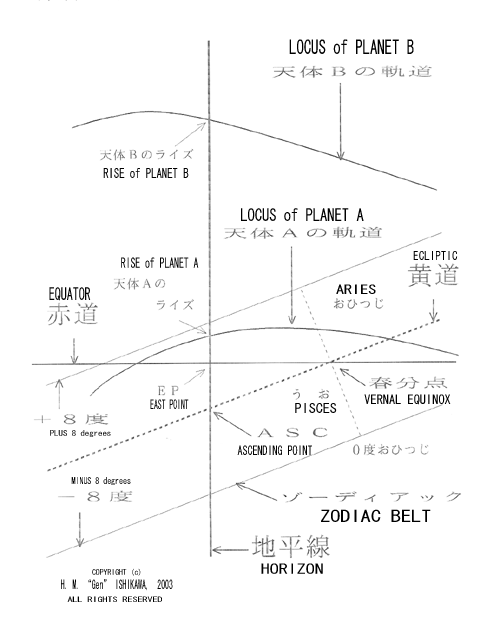アセンダント 2 ・ ASCENDANT 2
石川源晃著


太陽がとおる黄道(こうどう)と地平線が交差する点をアセンダント・ASCと定めて、占星学では、多くの
天体が黄道を中心にして前後約8度の間に存在する天体Aとして研究してきました。ところが、実際には天体Bの
ように、ゾーディアック・ベルトに入らない天体が存在しているのです。すべての天体に共通する観念として、
上昇するという意味のライズを考えれば理屈が合うのですが、地球上の緯度の変化と個々の天体のサイン位置により
ライズの値が前後20度も大幅に変化するので、個々の天体につき地球上の緯度を考慮した個々のライズを使用した
個別のホロスコ−プ作成しなければならなくなります。現在は太陽の位置を基準に計算した一枚のホロスコープを
使用するのですが太陽以外の天体とアセンダント・ASCの関係は無意味なものです。ですから、恒星シリュース上昇
を歴史的な記録にしたエジプトの占星学は現在の研究では無意味な存在になります。
占星学が使用する一枚のホロスコープで判断する方法では、朝の夜明けとともに生まれた人物の
場合のアセンダント・ASCだけが有効であり、その他の人物の場合のアセンダント・ASCは再検討を
しなければならない場合があります。
The astrology has been studying the planet A that is located inside the zodiac belt of eight degree width from
the ECLIPTIC or the locus of the Sun. In the practical cases, however, there are some stars outside the zodiac
belt such as being represented by a planet B. The ascendant or ASC is the point crossing the line of horizon
with the line of ecliptic located. This ASC will be valid for planet A but not valid for Planet B. The point of RISE
that is the crossing point of the locus of individual sky body with the line of horizon will be reasonable in use
provided however we have to settle each rising point for each sky body studied. As the rising point will change
either plus or minus in twenty degrees from the ASC, in accordance with the location of observing point on earth
and the location of star in zodiacs, we have to prepare each horoscope for each sky body separately from the
general horoscope that is prepared on the place of the Sun as the representative of all sky bodies. Therefore,
the historical record of Sirius rising in Egyptian astrology will be no use in the modern age. As our system of astrology has been established on the single horoscope, we can only rely on the
specific type of horoscope that was calculated for the place of ascendant of a person born at the time of
Sun rise. For the person born in another moment, we should have studied an another type of horoscope
having another type of rising place for each sky body for each person calculated.

